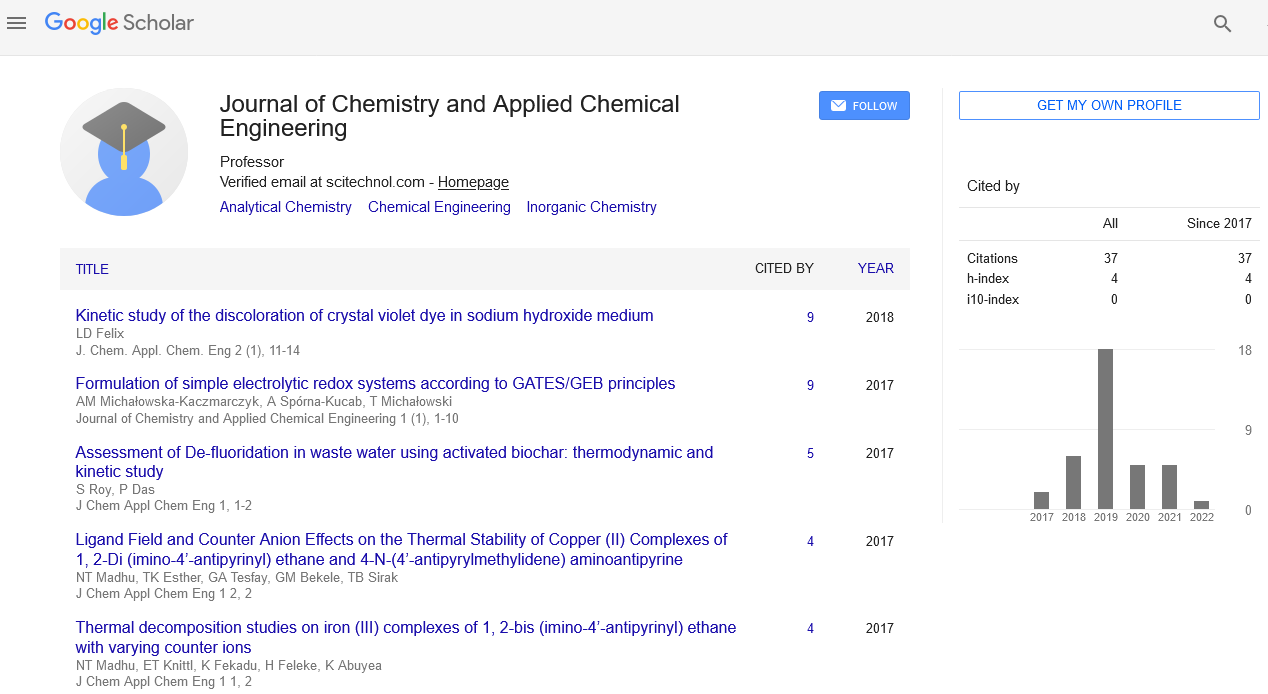Perspective, Chem Appl Chem Eng Vol: 7 Issue: 2
Green Chemistry and Sustainable Synthesis: Towards a Greener Future
Federico Castillo*
1Department of Chemistry, Friedrich Schiller University Jena, Jena, Germany
*Corresponding Author: Federico Castillo,
Department of Chemistry, Friedrich
Schiller University Jena, Jena, Germany
E-mail: castillofederico@gmail.com
Received date: 23 May, 2023, Manuscript No. JCACE-23-107627;
Editor assigned date: 25 May, 2023, Pre QC No. JCACE-23-107627 (PQ);
Reviewed date: 08 June, 2023, QC No. JCACE-23-107627;
Revised date: 15 June, 2023, Manuscript No. JCACE-23-107627 (R);
Published date: 22 June, 2023, DOI: 10.4172/Jcace.1000031
Citation: Castillo F (2023) Green Chemistry and Sustainable Synthesis: Towards a Greener Future. J Chem Appl Chem Eng 7:2.
Description
Green Chemistry, also known as sustainable chemistry or environmentally benign chemistry, is a philosophy and set of principles that aim to design and develop chemical processes and products in a way that minimizes the use and generation of hazardous substances. The concept of Green Chemistry emerged in the 1990s as a response to the growing environmental concerns and the negative impacts of traditional chemical practices on human health and the planet. Sustainable Synthesis, a core component of Green Chemistry, focuses on developing efficient and environmentally friendly methods for producing chemical compounds and materials.
Principles of green chemistry
Prevention: The first principle of Green Chemistry emphasizes the prevention of waste generation rather than dealing with waste after it has been produced. This involves designing chemical processes and products to be more efficient, with minimal by-products and waste.
Atom economy: The concept of atom economy is based on maximizing the incorporation of all starting materials into the final product, ensuring that fewer atoms are wasted during the synthesis. This principle encourages the use of renewable resources and sustainable feedstocks.
Less hazardous chemical syntheses: Green Chemistry promotes the use of safer and less toxic chemicals in chemical reactions to minimize the potential harm to human health and the environment.
Safer solvents and auxiliaries: The choice of solvents and auxiliary substances plays an important role in chemical processes. Green Chemistry advocates for the use of environmentally friendly and non-toxic solvents whenever possible.
Energy efficiency: Sustainable Synthesis focuses on developing energy-efficient methods, such as lower temperature and pressure conditions, to reduce the energy consumption of chemical processes.
Renewable feedstock: Incorporating renewable feedstock in chemical synthesis reduces the dependence on fossil fuels and promotes the use of sustainable resources.
Catalysis: Green Chemistry promotes the use of catalytic processes, which enable more efficient reactions with lower catalyst loading, leading to reduced waste generation.
Applications of green chemistry
Pharmaceutical industry: Green Chemistry has had a significant impact on drug discovery and development. Pharmaceutical companies are now adopting greener synthetic routes, which not only reduce environmental impact but also lead to safer and more sustainable drugs.
Materials science: Sustainable Synthesis techniques are being applied in the development of advanced materials with improved properties and reduced environmental footprints.
Agrochemicals: Green Chemistry principles have influenced the design of agrochemicals, leading to safer and more effective pesticides and herbicides with reduced ecological consequences.
Renewable energy: Green Chemistry plays an important role in the production of renewable energy technologies, such as solar cells and biofuels, by developing sustainable materials and processes.
Water treatment: Sustainable Synthesis methods are being employed to design more efficient and eco-friendly water treatment technologies, ensuring access to clean water while minimizing environmental impact.
Waste management: Green Chemistry principles are applied in waste management strategies, aiming to convert waste products into valuable resources through innovative recycling and upcycling processes.
Challenges and future prospects
While Green Chemistry and Sustainable Synthesis have made significant strides in promoting environmentally friendly practices, there are still challenges to overcome. The adoption of new technologies and processes requires investment in research, development, and implementation. Additionally, regulatory barriers and traditional practices can hinder the widespread adoption of green alternatives.
However, the future prospects for Green Chemistry and Sustainable Synthesis are promising. Governments, industries, and academia are increasingly recognizing the importance of sustainability and are investing in research to advance these fields. Moreover, consumer awareness and demand for eco-friendly products are driving companies to embrace greener practices.
Green Chemistry and Sustainable Synthesis are essential pillars of a sustainable future. By adopting the principles of Green Chemistry, industries and researchers can develop innovative solutions that protect human health, preserve natural resources, and mitigate environmental impacts. The integration of these principles across diverse sectors will contribute significantly to the transition towards a greener and more sustainable world, ensuring a better quality of life for current and future generations.
 Spanish
Spanish  Chinese
Chinese  Russian
Russian  German
German  French
French  Japanese
Japanese  Portuguese
Portuguese  Hindi
Hindi 